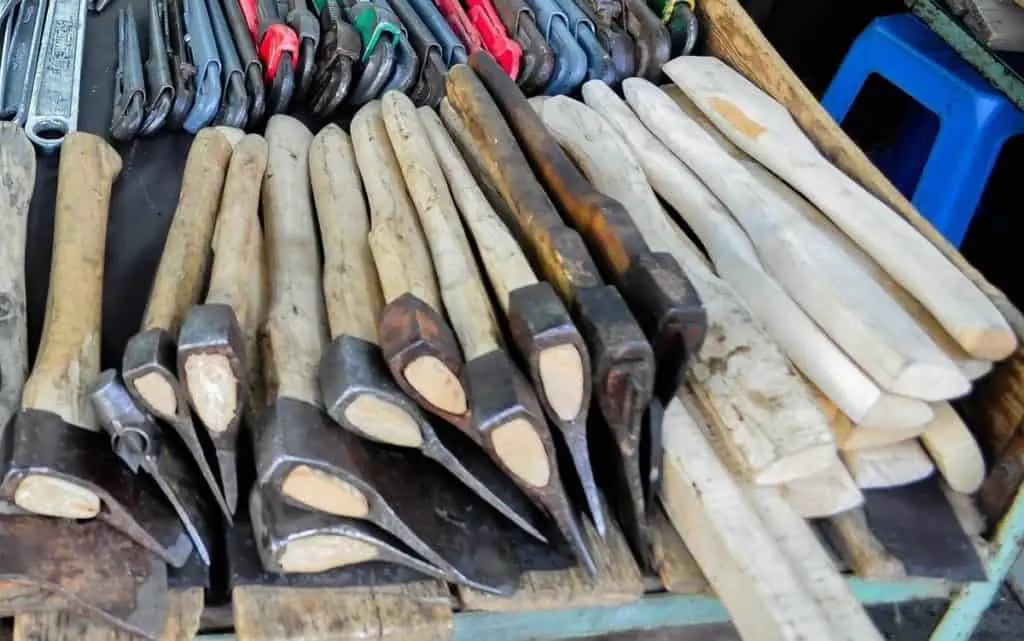
If you’re wondering who makes the best axe handles, then it’s probably fair to say that you care about the quality of your tools.
The trouble with modern axe handles, is that the broader market has traded quality for cheap production. If you’ve bought an axe handle at a big box hardware store like Lowes, or Home Depot, then you know what I’m talking about.
Sure, those handles are workable, but here’s a few downsides of low quality handles:
- The finish can give you blisters
- The grain/wood makes them weaker
- They won’t last as long
- They don’t look as nice
- They are more likely to crack (less safe)
These are just a few reasons why it pays to go for a high quality axe handle instead.
There are 3 leading brands, that understand and deliver on axe quality. Here they are:
There are probably some others as well (if you know of one, shoot me a note!), but these are some of the best , and highest quality brands for premium axe handles.
Below we’ll look at each one in a bit more detail, and then we’ll dive into what you should be looking for in a high quality axe handle. Let’s get to it!
3 top axe handle makers
1. House Handle Company
Background:
The House Handle Company is a family business, which has been making handles for a variety of hand tools (including axes) since 1964.
The business was originally started by William House, who partnered with his son, Kenny House. The company is still owned by the House family, and day-to-day operations are led by Kenny and his son Chris House.
The company has produced millions of handles in the last 40 years.
Handle grade:
The House Handle Company has a handle grading system, that indicates the quality of a product to customers.
You can find the details on their website here.
If I was buying a handle from them today, I’d go for their “AA” grade, which is the cream of the crop.
These handles are always made from sturdy hickory or oak, and are free from defects.
Special requests:
This company also offers something unique. For an extra dollar or two, you can add what they call Special Requests (see below):
- Handpicked handles
- No lacquer
- Octagon
If you decide to buy a handle from House Handle, I’d recommend getting options 1 & 2.
Option #1 means a staff member from the company will personally go to their supply, and select a good quality handle for you. This will give you the best chances of a handle that has the grain alignment, and design that ensures a quality tool.
Option #2 is helpful, because lacquer can mess your hands up. Using a handle with no lacquer is better.
Option #3 is really just a matter of personal preference, I’d skip this one personally.
Where to buy:
You can buy handles from the House Handle Company, directly through their official website.
2. Tennessee Hickory
Background:
The Tennessee Hickory company has been making and selling handles for over 90 years, and is based in the Tennessee River Valley.
Hickory is the undisputed best wood for axe handles.
The Tennessee Hickory company specializes in making hickory handles for striking tools (including axes). In fact, hickory is the only type of wood they work with for their handles.
The company values the environment, and their forestry practices are considered sustainable by the Appalachian Hardwoood Manufacturers, Inc. (AHMI).
Handle grade:
If you’re considering a handle from Tennessee Hickory, then I’d recommend something with their AAW or AW grades.
These grades provide the highest quality materials and construction that the company has to offer.
Both AAW and AW are all-white hickory, and you can get both with a wax finish, which I definitely recommend over a lacquer finish.
You can find all these details and more in thier official catalog.
Where to buy:
It’s a little more difficult to buy from Tennessee Hickory vs. House Handles above.
If you’re near their location in Tennessee, you can drop by and order one in person.
Otherwise, the easiest thing to do, is probably to email them and ask them where their closest distributor to your location is.
This is their email: sales@tennhickory.com
3. Gransfors Bruk
Background:
Rounding out the list, is one of our ongoing favorites on Burly Beaver.
Gransfors Bruk is a Swedish manufacturer of axes (and handles), which was originally founded in 1902. In the 1960s, they were producing over 200,000 axes per year.
Jumping ahead to the last 20 years, Gransfors Bruk has distinguished themselves as the Mercedes of axe manufacturers. Their tools are pricey, but they are extremely well designed and have become a little bit of a “status” purchase, that folks show off to their friends.
With Gransfors Bruk you pay a premium, but you can expect to get a quality product.
Handle grade:
Gransfors Bruk doesn’t use a grading system for their handles, like the other two companies.
However, similar to the high grade options mentioned above, you can expect a handle from Gransfors Bruk to be all-white Hickory with a wax finish.
Where to buy:
What you’d be looking for here, is a Gransfors Bruk replacement handle.
The best selection I’ve found for Gransfors Bruk handles is from Sheldon Hill Forestry Supply.
They’ve got a vareity of sizes and shapes, and you can order online and have it shipped to you.
If you want to learn more about Gransfors Bruk (the manufacturer), check out their official website.
What makes a “good” axe handle?
Type of tree
You heard us mention this above, but hickory is the best wood for the handle of a striking tool (like an axe).
Oak and ash are sometimes used as alternatives. Both can do a fine job, but for peak quality you can’t do any better than a good piece of hickory.
It’s worth noting, that axe handles can be made from other materials, like fiberglass. Wood is way better though, it’s more comfortable, it’s more environmentally friendly, and it looks better.
Cut of the wood
This one is best demonstrated with a simple photo.
The best part of a tree for making axe handles, is what’s called the “second growth”. On a hickory tree, this is a second white ring outside a darker colored internal core. See below:

Second growth handles, are usually all-white. So if you’re looking at a handle that has a lot of darker color, then you might want to pass until you find one that is truly cut from second growth wood.
Grain
Another important thing to consider, is the alignment of the grains.
In a good axe handle, the grains will run parallel to the the head of the axe.
For example, if you put the head-side of the handle on the ground and look straight down the end of the handle, the grains should go forward and backward, not side to side. See below:

When looking at this, keep in mind that there are natural curves to these lines from the growth of the tree. The idea is for them to be generally parallel, while realizing that it won’t be a perfectly straight line.
Axe handle red flags
Paint and finish
An axe handle that is painted, stained, or lacquered may look nice, but it also might be hiding defects in the quality of the handle. Not that the manufacturer is doing that intentionally or anything, but you just won’t be able to tell.
More importantly, paint and lacquer can be really hard on your hands for a striking tool like an axe. It can catch and rub your skin in a way that can cause hotspots and blisters. It’s better to go with a handle that has no finish, or just a wax finish.
Discolorations
If a handle has blended colors (dark and light), this might be a sign that they’ve taken some of the core of the tree, and the handle isn’t 100% second growth. This can make for a weaker handle.
If the handle has dark spots, this could also indicate a weaker spot on the wood, and splits may form their after using it for awhile.
With that said, some light color streaks on the surface, or on the ends of the handle, will probably not be a big deal.
Knots and splits
This is the most obvious defect to look for in a handle.
Look up and down a handle before buying it, to make sure there’s no knots in the wood. This is quick to check, and easy to recognize. Knots will make a handle much weaker, and more prone to breaking.
Definitely don’t buy a handle that has a knot in it.
And if a split is forming on a handle already, then don’t buy it! If it can’t sit in a store without forming a split, then it’s definitely not going to hold up during serious use.
Wrap-up
Alright, we’ve covered the highlights. Now you know 3 great manufacturers of axe handles. They may seem a little old-school, but then again, quality axe handles are also old-school.
Plus, we’ve also touched on some key things to look for in an axe handle, and what to stay away from.
If you’re new to this stuff, you might find some of our other posts interesting:
- Everything you need to know about Swedish axe makers
- What is a Rick of Wood?
- 5 Types of Log Splitting Tools Compared
I hope you found this post helpful, and if you think someone else might find it useful, then please feel free to share via email, social media, etc.
That’s it – now go do something awesome!
